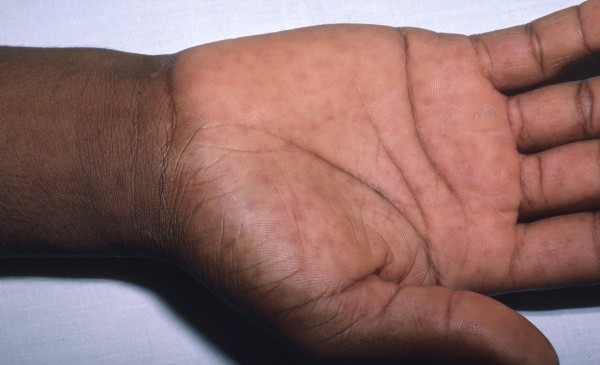Differential Diagnosis
- Human Anaplasmataceae infection
- Rocky Mountain spotted fever
- Acute meningococcemia
- West Nile virus

Diagnosis
This patient was diagnosed with Rocky Mountain spotted fever (RMSF). The rash in RMSF is characteristically seen on days 2-5 after fever, often with macules on wrists, forearms, or ankles and can spread to the hands or soles of feet. A petechial rash can be seen but often not until 5-6 days of illness with progressive disease and concomitant thrombocytopenia.
RMSF is caused by gram-negative Rickettsia riskettsii. It is spread by the American dog tick and Rocky Mountain tick. Infection occurs via a bite or by crushing the tick and transmitting the fecal matter to a mucosal surface (eg, by rubbing the eyes).
Despite its eponymous name, RMSF occurs over a wide distribution of locations throughout the contiguous United States, more commonly in Arkansas, Missouri, North Carolina, Oklahoma, and Tennessee. More than 90% of cases occur between April and September. Occurrence is more common in males, and higher in children than adults.
Case fatality rate without treatment, including in otherwise healthy adults and children, is 20% to 30% with a median time to death of 8 days. Though incidence in the U.S. has increased over the past several years (from 300–800 to 2,000 cases annually), fatalities have decreased due to enhanced recognition and early treatment.
Learnings/What to Look for
- Early clinical manifestations of RSMF include high fever, severe headache, myalgia, vomiting, and macular rash. Later manifestations include petechial rash, photophobia, confusion, ataxia, seizures, cough, dyspnea, arrhythmias, jaundice, and severe abdominal pain
- Thrombocytopenia or hyponatremia may be seen
Pearls for Urgent Care Management
- Diagnosis is made clinically, especially in prevalent areas during peak seasons. Serologic testing is available but typically not effective until after the first 5 days of symptoms when antibodies are detectable
- Doxycycline is the treatment of choice for all ages, including children and pregnant women and is most effective at preventing severe complications if started within 5 days of onset.1
- Fever typically subsides within 24 to 48 hours of initiating treatment. Severe illness may require longer periods of treatment before resolution of fever
- Atypical presentations, severe illness, or prolonged symptoms should involve infectious disease experts for more comprehensive evaluation
References
- Centers for Disease Control and Prevention. Rocky Mountain Spotted Fever (RMSF). Available at: https://www.cdc.gov/rmsf/healthcare-providers/treatment.html#:~:text=Doxycycline%20is%20the%20treatment%20of,children%20%3C8%20years%20of%20age. Accessed March 28, 2022.
Acknowledgment: Image and case presented by VisualDx (www.VisualDx.com/JUCM).
View More Rash Articles
- A Blistering Rash In An Otherwise Healthy 9-Year-Old Boy
- Rocky Mountain Spotted Fever: Dermatologic Manifestation Of A Life- Threatening, Systemic Disease
- A New-Onset, Suspicious Skin Lesion
- Top 5 Wilderness Medicine Topics For The Urgent Care Provider
